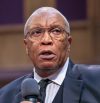My wife and I were recently in Los Angeles for a week of relaxation and refreshment with family and friends. At a dinner conversation someone asked if we had been downtown on Wall Street?
Of course we hadn’t, but I asked her why she thought we needed to see this particular area — this particular street? That question led to a discussion about the homeless and particularly about the homeless in Los Angeles.
She grew both animated and intense as she described to us the numbers of people that she sees. They were homeless. She used words like heartbreaking and unbelievable as she talked about these men and women pushing their carts with everything they own in the world to claim their space for the night. “Ken and Cloria, you have to see this.”
One night we drove downtown, picked her up from work (she is a high-level executive who works for a major financial institution). She would be our tour guide. It was a warm night. The darkness had already consumed the day. We drove just a couple of streets from where our friend worked and suddenly, the neighborhood changed. The well-dressed and well-heeled party-goers who had come down to enjoy the best of what the city of Los Angeles had to offer quickly were replaced by the “invisible inhabitants” of this city.
The word “invisible” is such an interesting word to me. In fact, whenever I see it, especially when it is used to speak about those who are living at the margins and under the margins, I’m reminded of Ralph Ellison when he talks about how the White world viewed African American people.
We were invisible, he said. Not because we did not exist but because the world made a conscious decision not to acknowledge our presence. I thought of Ellison’s “Invisible Man” as our eyes fell upon the homeless men, women and children who were camping out on Wall as well as the streets that surrounded it.
I read “Invisible Man” as a junior in high school. It left a deep impression when I read it then and the substance of it moved me once again as we drove through this mass of huddled pain trying to find a place to rest their heads and their bodies for the night. I wondered as we watched them walk slowly to carve out a spot what was going on in their minds, I wondered what brought them not just to the physical place of Wall Street but what was the nature of the circumstances that created this horrific reality where they could drop out of sight, check out of life and no one would miss them?
We were told that 100,000 people could sometimes fill these streets. We noticed several police officers patroling the area. But I wondered, was it to provide security or to contain them in the relatively small space that they had claimed at least for the moment before an expanding downtown would drive them to a new location?
There is a lot of wealth in Los Angeles. In the week that we were there we saw some of that wealth. As we drove into downtown that evening it was difficult not to notice the high-rises and the lofts that were homes to those who could afford that kind of real estate. We passed the new multimillion-dollar entertainment complex that served as the playground for the well-to-do and the rich and the famous.
America — a land of such promise and where dreams are made. This is the vision that so many of us grew up holding in our imagination, but there is this other side — this underside that is often so very close to us and that remains invisible to us — this is the America where dreams are nightmares. The neighborhoods are not tree-lined with well-manicured lawns and nice modest homes with white picket-fences. They are just streets lined with human beings who often have run out of hope and who make their beds on the cold, hard concrete sharing their space with the rats and roaches who scamper about looking for food.
As I watched several large rats run between the men and women who had already hunkered down for the night with only a blanket or a cardboard box covering them I wondered how many of them had ever been bitten.
“Jesus saw the crowds. They were like sheep without a shepherd. He was moved to compassion.” There are many places like Wall Street in Los Angeles. The poor and the homeless are all around us. Sometimes it just takes us getting out of our comfort zones and going to where they might be. Let’s not continue to keep them invisible.


